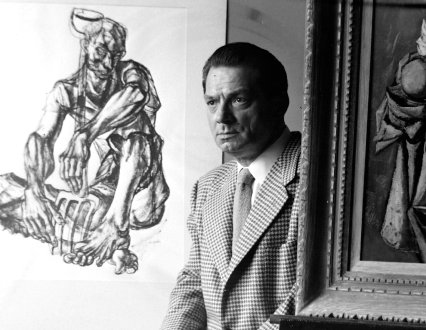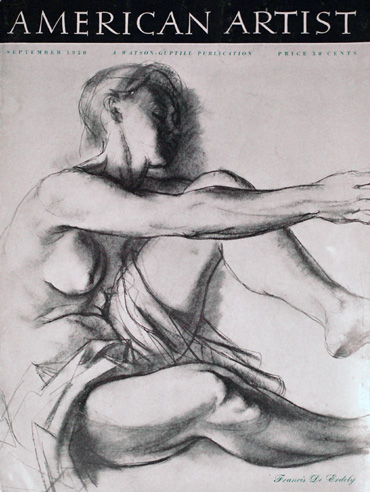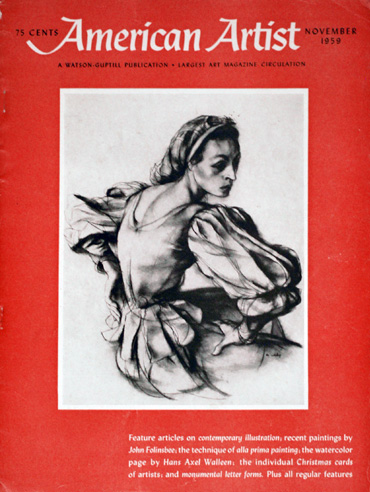Francis de Erdely (birth name: Erdélyi Ferenc) was born in Budapest, Hungary on May 3, 1904. He was a graduate of the Royal Academy of Art of Budapest. He also studied at the Academy San Fernando in Madrid, the Sorbonne in Paris, and in the Louvre. His pugilistic experience financed his studies for several years in Spain. He first achieved prominence in Hungary where, in Budapest, he won the Szinyei-Merse Grand Prize in 1925, then became well-known in Spain, Holland, Belgium, (Triennial Bronze Medal at Ghent, 1929) France, Czechoslovakia and Australia. His work had been commissioned or bought by the former Queen Mother of Spain, Maria Christina, the late Prince Hendrik of Holland and, of later years, by American museums and collectors. He had received resounding praise from critics, and won a total of 27 prizes in America since 1940-nine of these in 1949.
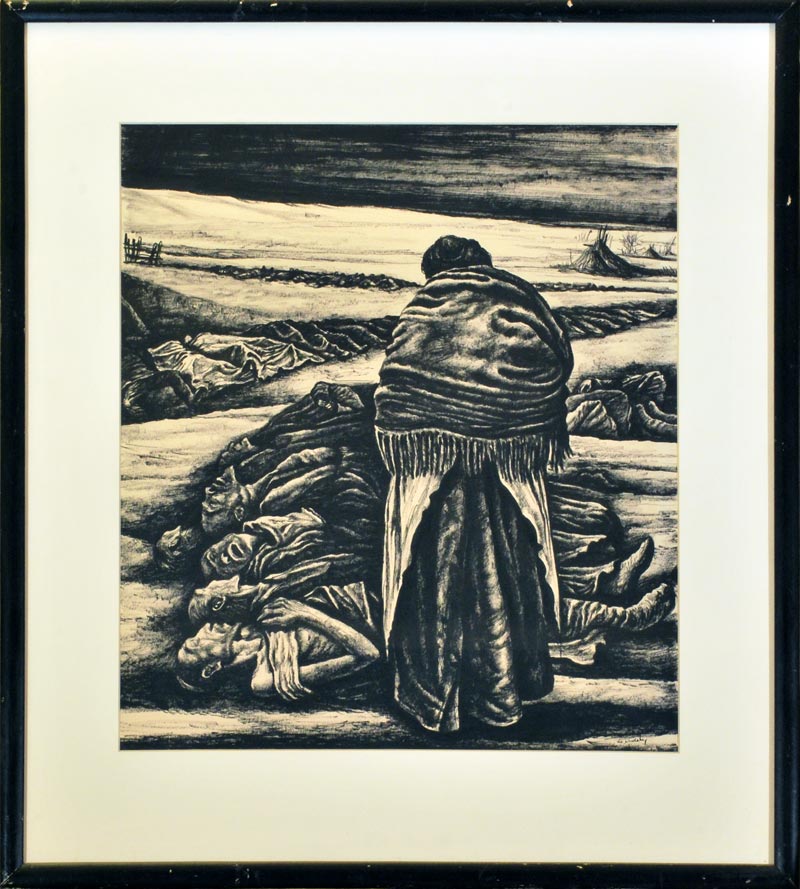 Few contemporaries have been honored by an accolade such as that conferred by Arthur Millier in the Los Angeles Times. Writing about De Erdely's Los Angeles. exhibition in 1944, Millier said, "Impressive as the 29 paintings are, the show reaches its climax in 14 large black-and-white drawings of the horrors of war which are worthy to stand with Goya's famed Disasters of War etchings." Alfred Frankenstein in the San Francisco Chronicle voiced his similar conviction that "they are among the most powerful drawings you will ever see."
Few contemporaries have been honored by an accolade such as that conferred by Arthur Millier in the Los Angeles Times. Writing about De Erdely's Los Angeles. exhibition in 1944, Millier said, "Impressive as the 29 paintings are, the show reaches its climax in 14 large black-and-white drawings of the horrors of war which are worthy to stand with Goya's famed Disasters of War etchings." Alfred Frankenstein in the San Francisco Chronicle voiced his similar conviction that "they are among the most powerful drawings you will ever see."
Frankenstein, remarking that De Erdely was once a professional boxer, said, "Perhaps that has something to do with the power and palpability of his figures. Innumerable artists have studied athletes in action; one who has himself been an active athlete may have an edge, so far as knowing the thrusts and articulations of the human body is concerned."
Francis de Erdely was an artist who has been thoroughly schooled in the ideals and the technique of traditional painting-sound draftsmanship, studied composition, persuasive surfaces, color harmony.
Commenting upon his approach to painting problems, he said:
"The birth of an idea is only the beginning of a lengthy period of intense searching into all its aspects. If it survives the test of time and various analyses from the standpoint of space and construction, then I am ready to consider different images of the idea. If it passes this test, as well, the positive medium of paper or canvas is indicated.
"My first step is generally a drawing in black and white, which may best be described as 'notes on the vision' and which is decipherable only by the professional painter. If the idea involves figures, I prepare three or four composition sketches, then I have the models pose substantially in the positions visualized. 'Whenever possible, I prefer not to use professional models because I find that after a series of studio, commercial, or illustrative poses they often lose the simplicity of ordinary human movement. While it is difficult to begin working with an inexperienced model whose shyness and inability to understand the situation have a tendency to inhibit the painter, once the nonprofessional's reserve has been broken down, the painter is rewarded by the model's richer analysis and fuller cooperation. After drawing from the model, I prepare a large black-and-white composition, as well as a color sketch in tempera or pastel, or possibly a combination of both mediums.
"If the original conception was too far-fetched or if imagination has outdistanced knowledge and creative capacity, the exaggeration or shortcoming becomes painfully evident at this stage. During these preliminary stages the conception of the picture has been essentially dualistic, what was conceived as a dramatic vision having been simultaneously abstracted through thought. The final image and the inner structure are developing at the same time.
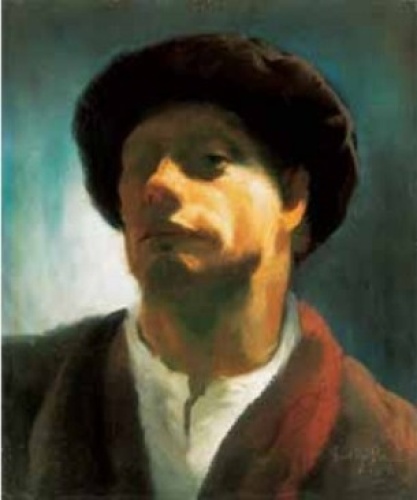 "After the color sketch has been completed, I turn to the canvas. I suppose it is one of my peculiarities that I must stretch the canvas myself. I prefer a medium-fine weave, which I rub down with sandpaper and treat with oil and turpentine.
"After the color sketch has been completed, I turn to the canvas. I suppose it is one of my peculiarities that I must stretch the canvas myself. I prefer a medium-fine weave, which I rub down with sandpaper and treat with oil and turpentine.
"My first step in the construction of the painting is the geometric division of the canvas. Once this is done, I am ready to block my figures lightly into the geometric divisions in charcoal. At this point, the original studies often require alteration in the interest of the final composition, for the reason that a model's attitude may have proved too rigid. The charcoal lines blocking-in the figures are then rubbed off the canvas. But, since the canvas has previously been treated with oil, Cine outlines of the figures are still visible. At this and every other stage the canvas must be clean, a personal rule to which I never make any exception. Using a very fine brush, I paint over the faint charcoal lines with burnt umber-afterwards indicating with a heavier brush the distribution of light and dark areas. This clears up the linear and spatial problems.
"When I begin to paint, I find that all my preliminary graphic studies must be forgotten. They have served their purpose of liberating my brush from problems of line and space, thereby giving it the fullest measure of freedom. I build my color scheme up by using the system of the conflict of warm and cold colors, blended of course with light. In the event that I reach a point where my conception appears to be wanting, I recall the model and work with him for a few hours, continuing to paint even after he has left in order to synchronize form and color in the painting, which a shaft of reality sometimes throws out of key.
"To use an expression common to the painting profession, when I have completely 'killed' my idea, the painting is finished.
"As a rule I do not use more than one model at a time, nor do I employ photographs, posed or otherwise. Here, however, I want to digress in order to give the photographer his due. While we painters have taught him how to compose and how to deal with light and shadow, he in turn, especially the motion picture cameraman, has taught us how to see from hitherto unknown or unexplored angles.
"To pass from the technical to the spiritual, in my student years at the Royal Academy of Art at Budapest after World War I, Rembrandt's work was a powerful influence. This was a natural result of the struggles experienced by my generation during the turbulent period, which inclined us toward a somber fantasy and a preoccupation with the drama of humanity. My devotion to Rembrandt at that time sprang more from reverence for his technical achievements than from any thorough comprehension of his genius. Other strong early influences were Daumier and Goya, who may be said to belong to the same 'family' of painters as Rembrandt. After completing my studies in Budapest, I was led by some adolescent intuition to Goya's work in the Prado–he was closer to me in point of time and more easily digestible than Rembrandt. During my years in Madrid I visited the Museum almost daily, concentrating on the work of Goya, Ribera, Zurbaran, and Velazquez to the complete exclusion of EI Greco, Titian, and Tintoretto, despite the fact that the latter are very well represented in the Prado. It was only when I revisited Madrid, years later, that I realized the magnitude of my sin of omission, particularly in the case of El Greco, and I have not forgiven myself to this day.
"While I lived and worked in Paris, Daumier, Delacroix, and Poussin were dominant influences. When I moved to Belgium, I could not escape the spell of Bosch and Brueghel, but their influence for the most part affected my conception of painting rather than my technique. After moving to The Netherlands, in 1931, I had a splendid opportunity to renew my acquaintance with the work of Rembrandt, my youthful ideal. But by that time I had reached a state of maturity and I was able to laugh at my early attempts to imitate his technique, for Rembrandt's full genius was now very apparent to me and no less apparent was the folly of attempting to reach the heights which he had scaled.
"When World War I broke out, I was at the impressionable age of ten. Ever since that holocaust, the history of much of the world, particularly Central Europe, has been a series of armed conflicts and social upheavals and dislocations. The great actor in this drama has been the human being. Therefore it is not surprising that man should be a more fascinating subject of study to me than landscape, still life, or ivory tower l'art pour l'art."
De Erdely was dean of the Pasadena Art Institute School from 1944 to 1946. In 1948, he became faculty of the Jepson Art Institute in Los Angeles. He was professor of painting at the University of Southern California from 1945 until his death on November 28, 1959.
His work is in the permanent collections of the museums of Madrid, Barcelona, Amsterdam, The Hague, Brussels, Antwerp, Ghent, Mons, Bratislava, Algiers, Jeu de Paume, Detroit Institute of Arts, M. H. De Young Memorial Museum of San Francisco, Los Angeles County Museum, Pasadena Art Institute, Denver Art Museum, and the National Gallery of Victoria in Melbourne, Australia.
Sources: Watson, Ernest W. Twenty Painters and How They Work, New York: Watson-Guptill Publications, 1950.
